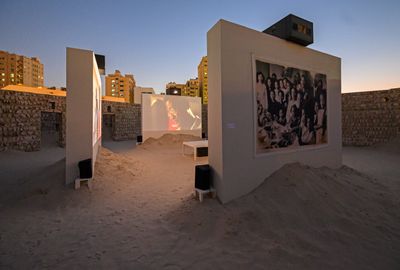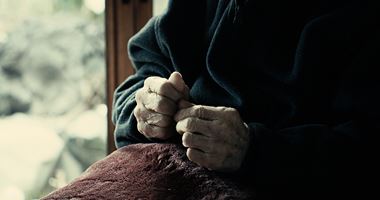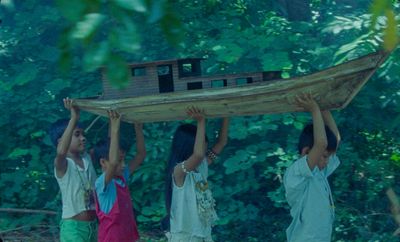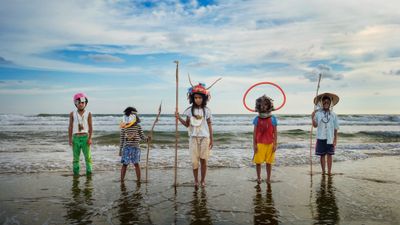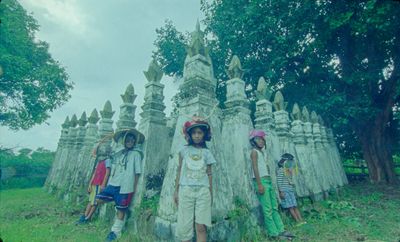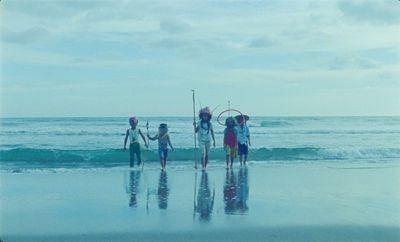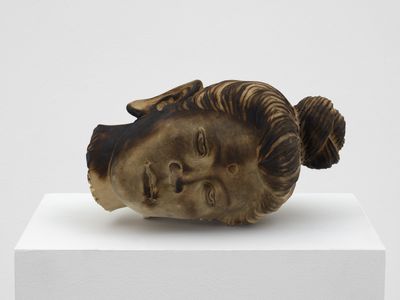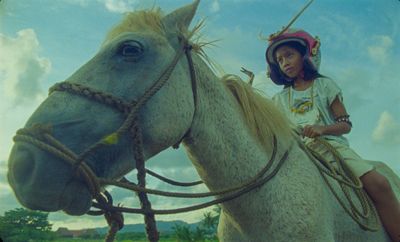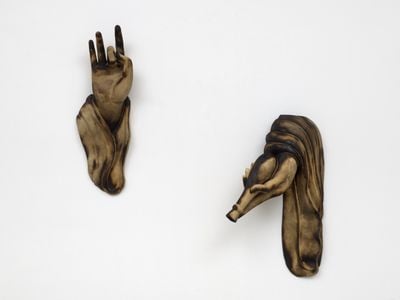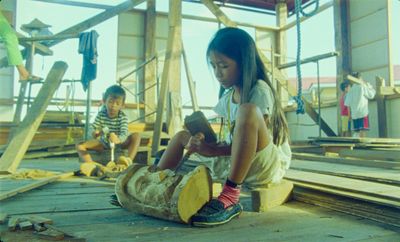Tuan Andrew Nguyen: The Limits of Narrative
Tuan Andrew Nguyen. Courtesy the artist, Bellas Artes Projects, and James Cohan, New York. Photo: Ansperniel Aquino.
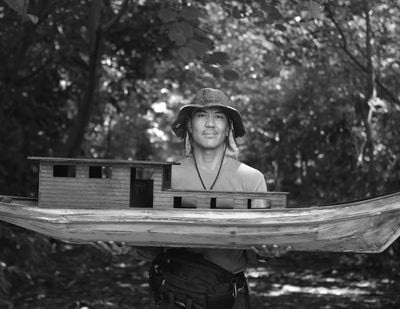
Tuan Andrew Nguyen. Courtesy the artist, Bellas Artes Projects, and James Cohan, New York. Photo: Ansperniel Aquino.
Ho Chi Minh-based artist Tuan Andrew Nguyen projects the calamitous legacies of colonialist and human conquests onto vividly imagined fictional worlds. Situated at the intersection of politics and history, his works employ Vietnam's spiritual culture and tumultuous past as grounding forces to navigate global systems of power.
Having co-founded the artist collective The Propeller Group and the non-profit art space Sàn Art, the 44-year-old has dedicated his practice to uncovering the deep interconnections between the colonisers and the colonised; the local and the universal; mankind and its surrounding world. Following on the heels of a successful world premiere of his film The Specter of Ancestors Becoming (2019) at Sharjah Biennial 14 (Leaving the Echo Chamber, 7 March–10 June 2019) and the San Francisco Museum of Modern Art last year, as part of the group exhibition SOFT POWER (26 October 2019–17 February 2020), Nguyen returns to New York with his first solo exhibition at James Cohan, titled A Lotus in a Sea of Fire (28 February–3 May 2020), now viewable online.
Though also featuring sculptures carved by Filipino artisans enlisted by the artist, the exhibition centres on The Boat People (2020), a roughly 20-minute video set in Bataan—a verdant province that lies across the Manila Bay from the Philippines' capital city, which became the site of untold violence during World War II and later, between 1980 and 1990, a place of refuge for thousands who fled Vietnam, Cambodia, and Laos.
Set to a score of rhythmic chimes, the video opens with vignettes of five children, cast from a local fishing village, who traverse an otherwise uninhabited land. Making their way across temples, cemeteries, museums, jungles, and seas, the group—soon revealed to be the last survivors on earth—seeks out objects steeped in memories of death and destruction: weapons used by the Japanese, American, and Filipino armies, and markers once placed to commemorate the treacherous journeys of the prisoners of war and refugees who set foot in Bataan. These discoveries become wayfinding tools for the children, who attempt to make sense of a world absent of adults.
Throughout the video, the group is seen meticulously carving replicas of these objects out of wood, before lighting them on fire. Whereas immolation is commonly viewed as an act of destruction, the children imbue it with an allegorical power to liberate and to cleanse material things from the painful memories enshrined by their existence. Nguyen reveals such intentions via a conversation, carried forth in both Tagalog and English, between the sole girl of the group and a stone head that she encounters on the beach. The head, severed presumably from a statue of the goddess Quan Yin, surrealistically takes on a human form as the girl converses with it. Their conversation—interwoven with shots of Buddhist and Catholic icons, and plaques and mementos displayed at various historical sites—puts into question many pieces of human knowledge that we seldom contemplate in a meaningful way. What is death? What does the concept of divinity truly mean?
Aptly titled after a book by the Nobel Peace Prize nominee and famed Vietnamese figure Thich Nhat Hanh, Lotus in a Sea of Fire not only pays tribute to the immense suffering of the countless lives that have been affected by humanity's inclinations towards destruction, warfare, and conquest; more importantly, it powerfully lays bare people's innate yearnings for forgiveness and compassion.
Although staged in a post-apocalyptic, fictional world, Nguyen's work feels remarkably relevant to the existential realities facing our global society today. Here, the artist shares his insights about his newest debut.
VCThe Boat People was produced in collaboration with Bellas Artes Projects, where you were an artist-in-residence in 2018. Did you already have the work in mind when you first travelled to Bataan, or did your experience there give shape to The Boat People?
TANI had been interested in the different sites of landing during the mass migration of Vietnamese, Cambodians, and Laotians after the end of the American war in Vietnam. These landing sites, some of which became refugee camps, were mostly coastal locations around Southeast Asia. In 2017 I made a film about Pulau Bidong, an island off the coast of Malaysia that was the largest and longest running refugee camp after the war, and had researched other sites, including Bataan.
Diana Campbell Betancourt, who was the artistic director of Bellas Artes Projects, invited me to come do initial research in 2018 and I ultimately returned in 2019 to do a longer stint there. The project happened quite quickly when I returned in 2019, but I essentially had a year to mull over the different sites and histories of Bataan—to think of Bataan through multiple events of conflict, trauma, and migration, and not solely the site of a major refugee camp.
VCWhy did you decide to centre the film on a group of children who inhabit an unpopulated, apocalyptic world? Is the fictional narrative at all tied to your own childhood experiences, as a young refugee who left Vietnam in 1979?
TANI was quite young when my family escaped by boat from Vietnam, so it would be difficult for me to say that it comes directly from that specific lived experience. But I can say that through my experiences interacting with young immigrants and refugees over the years, I came to understand in very visceral ways that there is a mutual sense of how frail the future is.
Of the many migratory bodies out there, which the main characters in the film essentially are, children are the most vulnerable. It's an extreme position, an extreme situation to be in for a child. So I thought about what could happen if we set that extreme subject into another extreme situation: the edge of humanity's existence. These children then become empowered; they become the saviours of humanity, almost godlike in their importance to the future of the world. And maybe that inclination to empower immigrant children does somehow come from my experiences.
VCMuch of the film's meaning is carried forth by the girl's dialogue with a stone head, which has been severed from a statue of Quan Yin. In Buddhism, Quan Yin is believed to represent compassion and mercy; in the video, the girl not only acts as a nurturing figure for the other children but, more importantly, is driven by a symbolic desire to liberate objects from painful memories. How does this shared compassion relate to the exhibition's overarching themes surrounding colonialism, war, and religion?
TANIt's intentionally ambiguous as to where the head was severed from. There's a scene where the main character—the girl as you mentioned, or The Last Woman On Earth, as we call her—spends a significant time observing a Quan Yin statue built by Vietnamese refugees, but there's also a moment in the film where she pops out from behind a headless statue of Shakyamuni Buddha that was built by Laotian refugees. Additionally, there's a scene where the girl is carving a head as she's working with her crew.
I don't subscribe to the idea that repair is an option within a post-colonial context, where so much has been decimated historically; but I do think shared compassion is an immensely useful tool, philosophically and in practice.
Regardless of how individual viewers read the identity of the severed head, the idea of compassion remains an important one. I don't subscribe to the idea that repair is an option within a post-colonial context, where so much has been decimated historically; but I do think shared compassion is an immensely useful tool, philosophically and in practice. It is completely constructive, without being victim to the past, and without being subservient to the future. Hence, I believe that shared compassion is empowering.
Compassion and empathy are also stepping stones towards solidarity, which was a crucial concept towards the middle of the 20th century in thinking about decoloniality. They unite, while oftentimes religion and colonialism have divided and destroyed us.
VCThe girl speaks Tagalog, but the statue responds in English. Why is that? Could you explain the reasoning behind the scene wherein the children educate themselves with English language textbooks?
TANI humorously imagined that the head—besides having godly powers of omniscience—had also spent quite a bit of time in Bataan and witnessed several waves of migrations and different communities coming and going, and picked up on English through it all. The classroom was a very important space in the refugee camps where refugees were 'prepped' for life in their potential 'third' country—their country of resettlement. The museum of the former Philippine Refugee Processing Center kept much of the furniture and books that were used in those classrooms, along with temporary shelters, detention centres—called 'monkey houses'—and so on. I wanted very much to engage these sets, especially the classroom setting, and bring life into them again.
Language has the potential to be an oppressive tool, especially for people who are stateless, who find themselves having to prove themselves and be spoken for. The border space is where the power play of language is enacted, often violently. I've seen too many instances where English speakers are quite condescending to non-English speakers. For many Vietnamese refugees, for instance, learning English meant being able to leave the refugee camp and getting accepted by a third country, like the U.S. or Australia or parts of Europe.
Having characters speak in two languages—and simultaneously being able to understand each other without reason—is something I've explored and experimented in other films. The ability to understand one another across languages is a post-colonial and a diasporic condition that also eliminates, or at least challenges, the power dynamics of language left behind by colonialism. I also believe having multiple languages spoken without disruption or breaks for translation creates a situation where the viewer is placed in a space where they are forced to be very alert to how language moves and functions. Access to aural understanding is intermittent.
VCWhat is the significance of the headpieces—fashioned out of found household objects—that the children wear?
TANI wanted to show that the characters had a history of scavenging and collecting that was different from the way they collected the objects they burn—that their attempts of understanding and making or remaking the world were broad.
For me, that way of expressing the diversity in which they understood materiality and the found object was in how they adorned themselves with these objects. It was a different way of carrying the relics of humanity. I think it reflects a need to protect themselves—in masks, hats, or helmets, for instance—but it also reflects a need to express and be creative, to turn the things they carried both literally and figuratively into their own distinct identities, which is another type of protection I guess.
VCThe burning of wooden objects brings to mind an earlier work by you—Enemy's Enemy: Monument to a Monument (2012), a baseball bat bearing a carved image of Thich Quang Duc, the Buddhist monk who infamously set fire to himself in 1963 as an act of protest against the South Vietnamese government's religious repression. Is there a similarity, in your mind, between the children's act of burning objects, and Quang Duc's sacrificial act of self-immolation?
TANThere's a way that spiritual practices, specifically in Vietnam, have been embedded with strategies of political resistance. In another instance, fire and self-immolation have been well-known acts of political resistance, where the spiritual and the political collide. Fire becomes a strong metaphor for freedom and liberation, both spiritual and political.
This of course is exemplified in Thich Quang Duc's act of self-immolation. The image of this action has been burnt deeply into my own psyche. The many, many acts of self-immolation in Tibet currently in protest of China's violent decimation of Tibetan Buddhist culture is another ongoing example of these collisions between the spiritual and the political—the struggle for freedom.
My individual practice is invested in exploring the limits of narrative: both the power of storytelling and its abuses.
Thich Nhat Hanh, a Vietnamese Zen monk and scholar who was nominated by Dr. Martin Luther King, Jr. for a Nobel Peace Prize in 1967, wrote a book titled Vietnam: Lotus in a Sea of Fire, in which he attempts to explain to Western audiences, who mostly saw the act of self-immolation as violent and primitive, that the monk's act, although an extreme act of political protest, was also one of intense compassion and one with extreme philosophical sophistication. There are many ways to burn. And that for me is the space where these two acts of burning can exist in dialogue with one another.
VCDo you approach your individual art practice differently from your work as part of The Propeller Group? Aside from the latter being a collaboration with other artists, are there certain themes or creative processes that are specific to your own practice?
TANIn my work with The Propeller Group, I am thinking about the memory of the Cold War and its residual effects on how we perceive and how we relate to one another in the present day. In my individual work, I am thinking about memory and its potential for political resistance. My individual practice is invested in exploring the limits of narrative: both the power of storytelling and its abuses. TPG was founded with the intention of exploring the mechanisms of narrative—in propaganda, advertising, and media, for example.
There are slight differences in how I approach the two ways of working. For instance, in the collective work I get to be very cerebral and strategic, and in the personal work, I'm allowed to be more emotionally charged. There's an emotional element in my own work that isn't as apparent in the collective work, but there is definitely an overlap between the two ways of working. The initiating of The Propeller Group is a part of my overall practice; maybe to see it as a project, a collective, and a part of my practice is the way to go.
VCLooking ahead, are there new projects that you are currently working on?
TANAt the moment, I am working on a new project that combines film and performance. It's in collaboration with immigrants and undocumented migrants—a term I'm quite uncertain about, but will use for now for lack of better terminology—in Marseille. The project is tentatively titled Crimes of Solidarity, which is an informal term pointing to the criminalisation of assistance to undocumented migrants in France.
I am working with the tenants of the Saint-Just squat—the largest squat in Marseille that shelters over 300 people seeking asylum in France—along with a high school teacher named Mathieu Do Duc, a Vietnamese refugee to France in the 1960s who stood up to protest the deportation of two students from his school.—[O]


